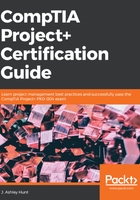
Cost-benefit analysis
An easy way to think of a cost-benefit analysis is to look at both what the project will cost and whether it's worth it to undertake said project with limited information. Predicted costs versus the benefits to the organization will be analyzed. In this case, it is mostly money-oriented. A benefit-cost ratio (BCR) takes into consideration the benefit/cost formula. Keep in mind that the numbers that are being analyzed are based on expert judgment, historical information from similar projects, and projections in the current market.
The result of a benefit-cost analysis will be represented as a ratio. For example, if we assume that our organization will receive a return on investment (ROI) of $500,000 and we will have to spend $300,000 to make that happen, our BCR = 1.67 which could be construed as an ROI of 167% return. Conversely, if we spend $500,000 and get $300,000 back we would have a BCR of 0.6 or a 60% ROI, which isn't a good result. That project would be considered too financially risky to take on.